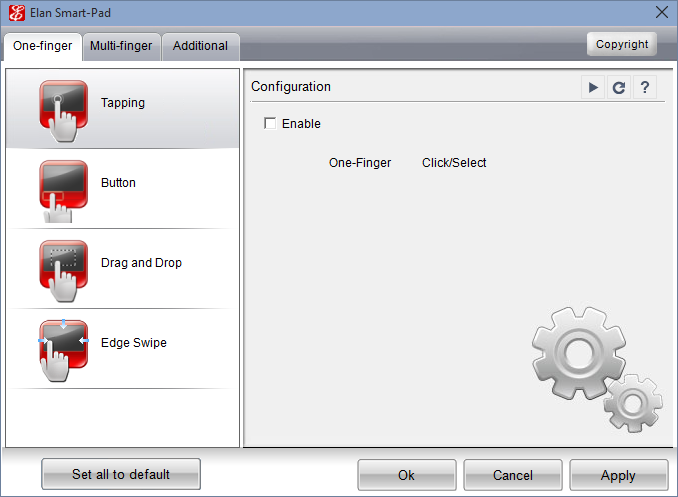Updated: June 20, 2015
If you thought Linux was bad when it comes to touchpad, then you need to read this. Now, it all begins with Lenovo Y50, which has a special Apple-wannabe trackpad, touchpad, whatever you wanna call it, supporting some serious fingering. One finger, two fingers, a whole fist, you name it. But sensible people just want a plain mouse control and no shitty tapping.
This is where the problem escalated so quickly. One, removing the Synaptics driver is the best kneejerk option, but then you're left with no control over a still crappy touchpad. And two, the issue also affects my G50 box, which is used for testing, including Linux distros but also Windows 10 Build 10041. And guess, it suffers from the same woes, because the default build comes with no special drivers for Lenovo hardware. Let me show you how you can try to fix this nonsense.
Generic fixes
If you don't want to be using the Synaptics driver and utility, or you do not have one, then you are left with the generic driver, which might be a little slow, and you still might be affected by stupid and pointless tapping. To resolve this, Windows 8/10, we will fiddle with the registry a little bit.


Registry games
The easy thing is to disable touchpad altogether. Launch regedit, then navigate to:
HKEY_CURRENT_USER\Software\Microsoft\Windows\CurrentVersion\
PrecisionTouchPad\Status

Here, you can toggle the status to 0, if you want it disabled, or 1, if you want it enabled. To make things easier, or faster, you can also create a couple of registry files that you can then save somewhere, and double-click to merge with the registry whenever you feel like toggling the touchpad status.
Windows Registry Editor Version 5.00
[HKEY_CURRENT_USER\Software\Microsoft\Windows\CurrentVersion\
PrecisionTouchPad\Status]
"Enabled"=dword:00000001
And also, the other way around:
Windows Registry Editor Version 5.00
[HKEY_CURRENT_USER\Software\Microsoft\Windows\CurrentVersion\
PrecisionTouchPad\Status]
"Enabled"=dword:00000000
Another option is just to slow down tap response, or disable it altogether. You will need to navigate just one level up in the registry hive, back to:
HKEY_CURRENT_USER\Software\Microsoft\Windows\CurrentVersion\
PrecisionTouchPad
Here, you can change the value of several keys, including scrolling and edge action, but most importantly the tapping threshold, as defined under AAPThreshold. This key can take five different values.

The available options are:
0 = No delay (always on)
1 = Short delay
2 = Medium delay (default)
3 = Long delay
4 = Turn off taps
That should sort of calm you down, to a point. This may not work, though, and you might have to reboot to see some of the stuff come into effect. Either way, it's a very restricting situation, and we definitely want to avoid ever being in it.
If you want to use the Synaptics driver
Then you will have to manually download the correct version from your vendor's site. Generic drivers will probably not work on most laptops, due to OEM signatures and similar nonsense.



While this option may help, it does not guarantee satisfaction. You may discover that some of the features simply cannot be changed. Moreover, almost universally, each and every laptop will be different, forcing you to explore new shitty GUI tools that weight 300MB just so you can control your taps.
In Ubuntu, for instance, it's one tool only, and that's how it's meant to be, because you control hardware through the operating system, and not the other way around. Why should there be more than one touchpad utility in Windows? Worse yet, why should there be more than a single Synaptics utility? Why complicate things so much?
So you see, it's a chicken and an egg problem, and they have both been scrambled together in a blender. In my previous article, we removed the Synaptics driver because it was crap. Then, in this one, I'm telling you, sometimes you may not have a choice, so you might need to keep it or install it back or similar. And it's still imperfect, whichever way you choose to go.
In all likelihood, you will be forced to use an external mouse, which is always a superior option. Just get those silly taps disabled. And so we thank the vendors for their support:

Conclusion
Phew, you thought Linux was the devil. But at look at this lovely combo. I must admit it's Lenovo and Microsoft, as I've never had problems with Asus trackpads or touchpads or whatever. If there's anything that can make you want to send your hardware back, it's definitely when your mouse clicks randomly while you're typing. I can't think of anything more retarded except trying to tattoo a butterfly on your genitals with an arc welder.
I can't think of any one specific domain in Windows that sucks more than touchpad support. It's non-standard, you need third-party tools to manage the hardware, and each and every one is different, with its unique, custom clicks and swipes and gesture and similar nonsense. Where all that most people ever want or need is just to disable taps while they type. Microsoft, please sort this out, and save everyone a few hundred MB of space. You don't really want people going into the registry, now do you? And you my readers, not really sure if I helped, but if I did, enjoy it.
Cheers.